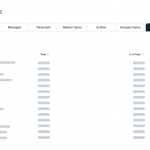From Data to Decisions: How to Communicate Contact Center Insights to Public Sector Leaders
From Data to Decisions: How to Communicate Contact Center Insights to Public Sector Leaders

Massive advances in technology have created citizens and students who are much more empowered than before. And accurate, ongoing interaction insights that help you understand their preferences and behavior are the only way to meet the rising and evolving expectations for the service & support you provide.
Unfortunately, most contact centers at public-sector organizations and educational institutions still try to learn what citizens/students think by paying expensive market research firms to poll them and engage them in focus groups. Even organizations and institutions that recognize the true scope of powerful voice-of-the-citizen (VoC) insights remain largely unable to sufficiently tap their internal data goldmine — a goldmine trapped within hours of call recordings, gigabytes of chat transcripts, and other records of citizen/student interactions.
That’s because mining the data and creating reports that detail the findings used to require a painful, manual process staffed by a dedicated team of data scientists and business intelligence professionals. And most contact centers simply couldn’t stomach an initiative of this kind because it took way too much time, money and resources.
Fortunately, today’s contact center analytics tools make it simple and intuitive for any user to find the valuable information on citizen/student trends hidden within their interaction data. And that’s a monumental improvement over the past.
But it’s only the first step.
The second and equally important step is knowing how to present contact center insights to the C-suite.
That’s because C-suite executives demand clear, data-based explanations to justify changes to business plans. They want to know “How can we use this information to improve services & experiences or streamline operations both in and beyond the contact center?”
But contact centers often have a tough time presenting citizen/student interaction data in effective ways — ways that inspire leaders to act — since each C-suite executive’s background, technical expertise, and experience usually varies widely. And that variation means even the most valid recommendations from the most credible contact center leaders can go unheeded if they aren’t communicated in a way that resonates with each leader.
So how can you effectively present your contact center interaction data to the C-suite?
Here are five tips.
1. CUSTOMIZE YOUR MESSAGE BASED ON YOUR AUDIENCE
First and foremost, cater your messages to each stakeholder’s individual needs, priorities, and motivations.
You don’t, for instance, need to explain ad-nauseum your entire research and analysis process to all of them. Some execs feel comfortable making a decision after they simply understand the basics of an approach. Others might require a deeper technical understanding. And yet others may want to know how your ideas will impact the contact center and the organization/institution.
Remember, you can always offer detailed, follow-up discussions to satisfy those execs who crave more detail about your process.
2. SPEAK THE LANGUAGE OF YOUR AUDIENCE
Put yourself in your audience’s shoes and present your message using terms that resonate with their role in the organization.
A technical deep dive into speech analytics, for instance, might be called for when presenting citizen/student insights to the CTO. But do the same with a CFO unfamiliar with the concepts, and you’re likely to see them grow frustrated or bogged down trying to grasp that level of detail.
Also, use technical phrasing and jargon sparingly. If it’s not necessary to use a technical term to convey your message, don’t use it (you’ll be surprised how much you can indeed say without using complex, niche terms).
But if it’s truly necessary to use technical jargon — and you’re confident your audience will understand it — define it upfront using context everyone understands.
3. CONVEY INFORMATION — DON’T JUST PRESENT DATA
Steer your audience toward the conclusion you want them to draw — don’t risk your C-level execs drawing their own conclusion about what your data means by delivering a presentation that’s long on data but short on explanations.
For example, say you want to expand a new training program because your data shows it’s slowed the rate at which your AHT (average handle times) are increasing. If you simply present raw AHT data to someone on the executive team, they might focus solely on the continued increase in AHT and be oblivious to the positive impact the new training program has and can continue to unleash!
Relate the data to your message, explain why it matters, and articulate clearly what your recommended course of action is.
4. BE SELECTIVE WITH THE INFORMATION YOU PRESENT AND HOW YOU PRESENT IT
Present the highest level of detail you can while still conveying everything your C-level execs need to know. And present the most valuable information first to capture and keep their attention.
In other words, don’t succumb to the temptation to proceed chronologically by explaining your analysis and showcasing the data before you discuss action items — that’s a surefire way to lose the interest of C-level executives. Equally important is including the right amount of information — too much or too little detail can cause your audience to become lost, detached, or bored since different executives have different responsibilities and priorities.
Remember, the level and granularity of content you share should speak to those unique needs of who you’re speaking to — ultimately, it’ll be easier to get them invested in caring in your message.
5. BE SELECTIVE WITH THE DATA VISUALIZATIONS YOU USE TO COMMUNICATE YOUR QUANTITATIVE MESSAGE
You want your visualizations to help your audience quickly and efficiently understand the data and message you’re trying to communicate. So, ask yourself these questions when preparing presentations about your data:
- What’s my audience’s comfort level with different types of graphs?
- Which type of visualization will best emphasize my point?
- How much explanation will my audience need?
In general, use the simplest visualization available that will convey all the necessary information. So, if a basic column chart is the clearest way to communicate your conclusion, don’t muddy the water by using a confusing, novel radar chart.
Strike a balance of visualizations. While a well-designed chart or graph can go a long way toward increasing the impact of otherwise-complicated concepts, visualizations can lose their intended effect — even detract from your message — if you aren’t selective about them. Use too many graphs, for instance, and your audience may focus solely on the slides instead of listening to what you say. Use no visualizations, on the other hand, and it may be hard for your audience to follow your message.
Whichever method of data representation you choose, remember to first introduce it to your audience first — explaining what the visualization shows and why it matters.
Finally, remember…
To those unfamiliar with the day-to-day workings of a contact center, citizen/student interaction data (that you see every day) can come across as confusing or even irrelevant.
So, present your message in a way anyone can understand, and you’ll be on your way to helping your contact center create meaningful impact. Impact that goes beyond your educational institution/public sector org, raising the bar for your Citizen’s Experience!
Eager to learn how Calabrio GovSuite can enable you to meet the evolving demands your Public Sector Contact Center faces?



